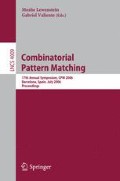Abstract
The Range-Minimum-Query-Problem is to preprocess an array such that the position of the minimum element between two specified indices can be obtained efficiently. We present a direct algorithm for the general RMQ-problem with linear preprocessing time and constant query time, without making use of any dynamic data structure. It consumes less than half of the space that is needed by the method by Berkman and Vishkin. We use our new algorithm for RMQ to improve on LCA-computation for binary trees, and further give a constant-time LCE-algorithm solely based on arrays. Both LCA and LCE have important applications, e.g., in computational biology. Experimental studies show that our new method is almost twice as fast in practice as previous approaches, and asymptotically slower variants of the constant-time algorithms perform even better for today’s common problem sizes.
Access this chapter
Tax calculation will be finalised at checkout
Purchases are for personal use only
Preview
Unable to display preview. Download preview PDF.
References
Aho, A.V., Hopcroft, J.E., Ullman, J.D.: On finding lowest common ancestors in trees. SIAM J. Comput. 5, 115–132 (1976)
Harel, D., Tarjan, R.E.: Fast algorithms for finding nearest common ancestors. SIAM J. Comput. 13, 338–355 (1984)
Schieber, B., Vishkin, U.: On finding lowest common ancestors: Simplification and parallelization. SIAM J. Comput. 17, 1253–1262 (1988)
Berkman, O., Vishkin, U.: Recursive star-tree parallel data structure. SIAM J. Comput. 22 (1993)
Bender, M.A., Farach-Colton, M.: The LCA problem revisited. In: Gonnet, G.H., Viola, A. (eds.) LATIN 2000. LNCS, vol. 1776, pp. 88–94. Springer, Heidelberg (2000)
Bender, M.A., Farach-Colton, M., Pemmasani, G., Skiena, S., Sumazin, P.: Lowest common ancestors in trees and directed acyclic graphs. J. Algorithms 57, 75–94 (2005)
Gabow, H.N., Bentley, J.L., Tarjan, R.E.: Scaling and related techniques for geometry problems. In: Proc. of the ACM STOC, pp. 135–143. ACM Press, New York (1984)
Gonnet, G.H., Baeza-Yates, R.A., Snider, T.: New indices for text: PAT trees and PAT arrays. In: Frakes, W.B., Baeza-Yates, R.A. (eds.) Information Retrieval: Data Structures and Algorithms, pp. 66–82. Prentice-Hall, Englewood Cliffs (1992)
Manber, U., Myers, E.W.: Suffix arrays: A new method for on-line string searches. SIAM J. Comput. 22, 935–948 (1993)
Kasai, T., Lee, G., Arimura, H., Arikawa, S., Park, K.: Linear-time longest-common-prefix computation in suffix arrays and its applications. In: Amir, A., Landau, G.M. (eds.) CPM 2001. LNCS, vol. 2089, pp. 181–192. Springer, Heidelberg (2001)
Abouelhoda, M.I., Kurtz, S., Ohlebusch, E.: Replacing suffix trees with enhanced suffix arrays. J. Discrete Algorithms 2, 53–86 (2004)
Alstrup, S., Gavoille, C., Kaplan, H., Rauhe, T.: Nearest common ancestors: A survey and a new distributed algorithm. In: Proc. SPAA, pp. 258–264. ACM Press, New York (2002)
Vuillemin, J.: A unifying look at data structures. Comm. ACM 23, 229–239 (1980)
Tarjan, R.E., Vishkin, U.: An efficient parallel biconnectivity algorithm. SIAM J. Comput. 14, 862–874 (1985)
Arlazarov, V.L., Dinic, E.A., Kronrod, M.A., Faradzev, I.A.: On economic construction of the transitive closure of a directed graph. Dokl. Acad. Nauk. SSSR 194, 487–488 (1970) (in Russian), Engl. transl. in Soviet Math. Dokl. 11, 1209–1210 (1975)
Knuth, D.E.: The Art of Computer Programming. Generating All Trees; History of Combinatorial Generation, vol. 4, fasc. 4. Addison-Wesley, Reading (2006)
Main, M.G., Lorentz, R.J.: An O(n logn) algorithm for finding all repetitions in a string. J. Algorithms 5, 422–432 (1984)
Gusfield, D., Stoye, J.: Linear time algorithm for finding and representing all tandem repeats in a string. J. Comput. Syst. Sci. 69, 525–546 (2004)
Landau, G., Schmidt, J.P., Sokol, D.: An algorithm for approximate tandem repeats. J. Comput. Biol. 8, 1–18 (2001)
Myers, E.W.: An O(nd) difference algorithm and its variations. Algorithmica 1, 251–266 (1986)
Landau, G., Vishkin, U.: Introducing efficient parallelism into approximate string matching and a new serial algorithm. In: Proc. STOC, pp. 220–230. ACM Press, New York (1986)
Gusfield, D.: Algorithms on Strings, Trees, and Sequences. Cambridge University Press, Cambridge (1997)
Schürmann, K.B., Stoye, J.: An incomplex algorithm for fast suffix array construction. In: Proc. ALENEX/ANALCO, pp. 77–85. SIAM Press, Philadelphia (2005)
Manzini, G.: Two space saving tricks for linear time lcp array computation. In: Hagerup, T., Katajainen, J. (eds.) SWAT 2004. LNCS, vol. 3111, pp. 372–383. Springer, Heidelberg (2004)
Sadakane, K.: Succinct representations of lcp information and improvements in the compressed suffix arrays. In: Proc. SODA, pp. 225–237. ACM/SIAM (2002)
Author information
Authors and Affiliations
Editor information
Editors and Affiliations
Rights and permissions
Copyright information
© 2006 Springer-Verlag Berlin Heidelberg
About this paper
Cite this paper
Fischer, J., Heun, V. (2006). Theoretical and Practical Improvements on the RMQ-Problem, with Applications to LCA and LCE. In: Lewenstein, M., Valiente, G. (eds) Combinatorial Pattern Matching. CPM 2006. Lecture Notes in Computer Science, vol 4009. Springer, Berlin, Heidelberg. https://doi.org/10.1007/11780441_5
Download citation
DOI: https://doi.org/10.1007/11780441_5
Publisher Name: Springer, Berlin, Heidelberg
Print ISBN: 978-3-540-35455-0
Online ISBN: 978-3-540-35461-1
eBook Packages: Computer ScienceComputer Science (R0)

